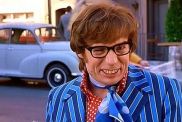There’s something undeniably eerie about the work of Justin John Greene. Shadows lurk on the walls of rooms that seem like they should be empty. Workers carry pained looks on their faces — feelings of despair, nothingness, and a sense of desperation crowd the canvases. In his solo exhibition Moonlighting at Loudhailer Gallery in Culver City, Greene conjures up sensibilities that remind one of the creative explosion that occurred during the Weimar Republic, the subject of a recent exhibition at LACMA, and a time (1919-1933) when Germany was rebuilding itself after World War I, soldiers were coming home maimed or not at all, consumerism was on the rise, women had more independence, and sexuality become a more free, fluid thing to explore. Much like the Weimar Republic’s New Objectivity (Neue Sachlichkeit) movement that asked questions about why Germany was in shambles, Greene’s work similarly leaves viewers without much hope.
Also: Books | Timeless: The Photographs of Kamoinge
Amidst the proliferation of shows these days that explore how the internet has changed our creative output, Greene’s show is refreshingly not-internet in its aesthetic choices. It’s also a not-so-subtle reminder of the current state of underemployment, and the under-earning that goes along with the economic downturn. In all of the paintings, however, there’s also a sense of hedonistic pleasure derived from not having “enough” work — a pleasure in the possibilities that underemployment offers, a certain state of “fun” that is always tempered by the anxiety of work. Greene takes inspiration from sources such as Cubism, film noir, old Hollywood, political cartooning, animations in the style of Tom and Jerry, and German Expressionism, all cast against a setting filled with classic L.A. palm trees. The work is eerily L.A., a testament as well to the reality that many people don’t work with any regularity.

Justin John Greene, “The Elysian” (2015). Airbrush media and oil on canvas. 60 x 48 in.
In the oil-on-canvas painting “Infinite Set” (2016), we see a woman, perhaps an actress, gazing into a mirror while reading a script. It’s unclear if the view out of her window is actually the ocean — if it is, we now get to assume that she lives in Venice! — or if it’s actually a painting of the ocean and a giant sun. Either way it doesn’t matter — she’s occupied in her own world, working on this part, forever burning the midnight oil. She seems determined to get this . . . role, or maybe just to get out of this spooky setting that she has created. On second look, it appears that she’s actually an artist painting a portrait, which serves as a great double-look, an uncertainty at the type of labor she’s actually participating in, which suggests the perpetual cycle she’s gotten herself into at this time. It doesn’t even matter what she’s actually doing at this point, so long as she’s producing, laboring on the Internet, creating content.
A similar situation takes place in “It’s Who You Know” (2016), an obvious nod to the common phrase used when trying to figure out how to get a job, or why one doesn’t have a job yet, or a justification for why one hasn’t yet acquired regular or temporary employment. Greene’s focus on hyper-realism in painting this desperate man on a phone brings to mind a scene from film noir, of a desperate man otherwise in black-and-white but now painting in color, who also happens to look like Sylvester Stallone. In the background, we see a house that looks like a colored-in, nightmarish setting from the German Expressionist film Cabinet of Dr. Caligari (1920) mixed with a sense of Cubist-inspired doom.

Justin John Greene, “It’s Who You Know” (2016). Airbrush media and oil on canvas. 36 x 24 in
Greene beautifully captures the uncertainty of a moment, a sense of waiting — not waiting for something to happen, but for some work-related answer, whether or not it will actually lead to work. There is a relief in accepting this not-knowingness, accompanied by an indifference, a complacency, and knowledge that he’ll probably try this phone call again another time, cold-calling, showing up for the mere possibility of work — it’s a reality that keeps evading him. Other noteworthy scenes portrayed in this show reference late night bar scenes, a sort of effervescence one observes in comedy club shows, the sense of cajoling with friends out on the town until closing time, a sort of whimsical (that’s the name of a few of these drawings, in fact) “devil may care” sensibility.

Justin John Greene, “Whimsical Evolution” (2015). Colored pencil on paper. 16.5 x 14 in. (19 x 16 in framed). Credit: Heather Rasmussen.
What the paintings don’t offer is any sort of solution to the problem of work — finding it or otherwise. We see only shadow-y figures, desperate or uncertain in their current situations, looking for some sort of way out. In The Elysian (2015), a woman lays in bed, nude, glued to her laptop, while a stoic-looking, angular man gazes out the window and onto the street. Greene’s paintings are a strange, eerie reflection of our contemporary creative working class reality, rife with the promise of “fun” but no hope. It is full of people caught in situations, not sure how they got there, and with no choice but to keep at it.







